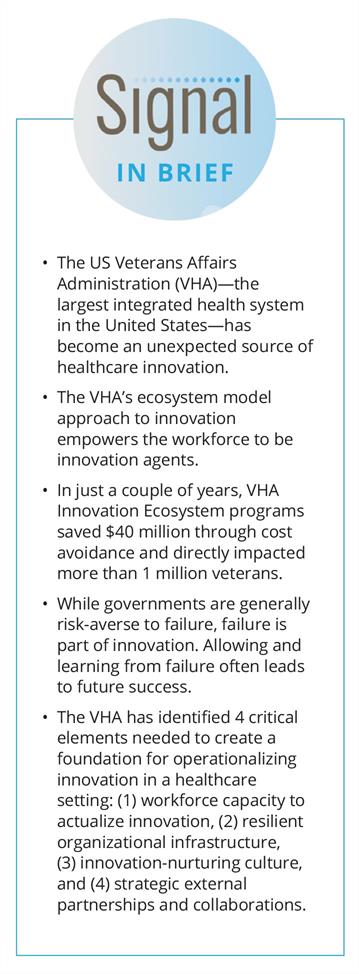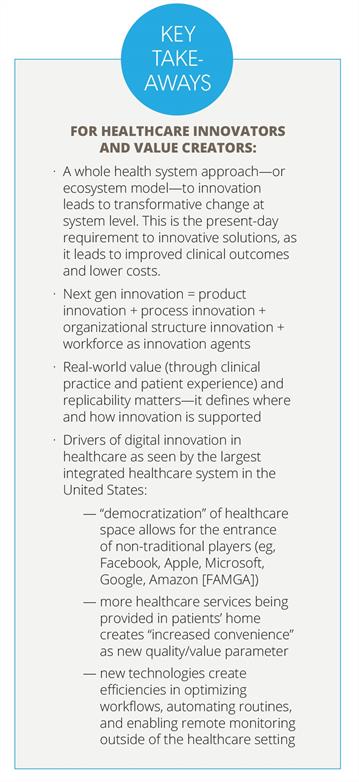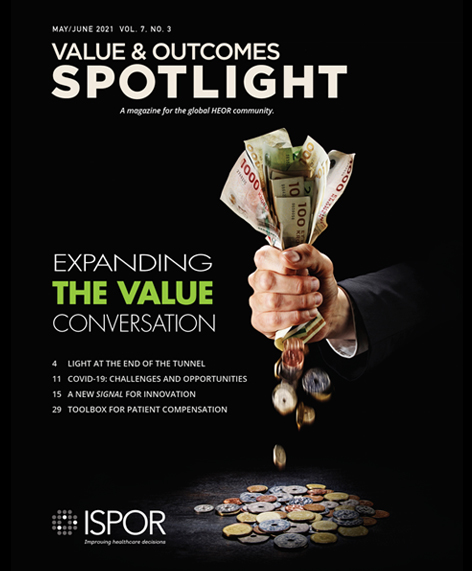ISPOR Generates a Signal for Transmitting Innovation
The inaugural episode of ISPOR’s new signature series, Signal, launched in April. The program is designed to look beyond today’s linear thinking to explore topics that will shape healthcare decision making over the next decade. When speaking with ISPOR CEO Nancy S. Berg about the genesis of the Signal series, she acknowledged that the pandemic has been a main driver in forcing businesses to look for new opportunities for collaboration and innovation…and ISPOR was no exception. “The COVID-19 pandemic has driven all healthcare organizations to the realization that innovation is not optional—it’s not a ‘good to have,’ it’s a ‘must do,’” Berg said. “We thought about what ISPOR and its members can do to improve the wider healthcare ecosystem and believe that the Signal series is a step in the direction of broadening our thinking, looking outward for ideas, and making HEOR part of fresh new approaches to innovation.”
Next Gen Innovation: A “How To” From the US Department of Veterans Affairs
The first Signal event highlighted a source of innovation from a place some might find surprising: the US Department of Veterans Affairs (VHA). While a target of criticism in past years, the VHA organization has proven itself as a true innovator. As explained by this Signal episode’s speakers, Ryan J. Vega, MD, MSHA, Chief Officer, Healthcare Innovation and Learning, Veterans Health Administration and Kenneth W. Kizer, MD, MPH, Chief Healthcare Transformation Officer and Senior Executive Vice President, Atlas Research, the VHA’s ecosystem has emerged as a model for supporting the entire life cycle of innovation in a large and highly complex integrated health system.

The VHA is the largest integrated healthcare system in the United States. There are 9 million enrolled veterans, with more than 1700 facilities across the country and in outlying territories, including 170 VA medical centers, 1074 outpatient facilities, and more than 500 community living, long-term care, and mental health counseling facilities. The large scale, closed system, and life-long care of its patients makes the VHA’s experience and insights about innovation relevant and transferrable to other healthcare systems beyond the United States.
The Keys to Innovation
The VHA’s ecosystem model approach to innovation combines product, process, and organizational structure together with continuous training and support, which empowers the workforce to be innovation agents. The model has produced programs aimed at the needs of veterans that both improve clinical outcomes and lower costs. Recognizing that challenges exist in how to estimate value when that value is often generated separately from costs, the VHA used different cost-sharing mechanisms and bundling services to apply a total cost of care approach. The results? In just a couple of years, the VHA Innovation Ecosystem has engaged 25,000 employees and more than 150 facilities in innovation projects and activities. These programs saved $40 million through cost avoidance and directly impacted more than 1 million veterans.
Solutions That Make a Difference
In thinking about value, the VHA starts with purposeful innovation to create the solutions that deliver the most impact to veterans; then moves on to implementing those solutions through partnerships, investing in people, or scaling; and then measuring those. “Measurement gets a little bit tricky,” Vega said, “because sometimes it’s not just about the qualitative data that you get. It’s also about the qualitative data—the voice of the veteran—telling us how valuable some solution is and that helps us get to the point that we are realizing value from these investments.”
Because each project is unique, it has its own set of metrics and outcomes that are being targeted. “The ideation around the problem has to drive the solutions. Ultimately, the success of a solution is measured by its real-world impact,” said Vega. The VHA has to take a very long view of veterans. “These are our patients, from the time that they transition and choose to come to the VHA and its care, to the time that they pass away. They’re ours for those years and decades of their life.” That means improvements can’t be episodic—the VHA has to look at a veteran’s life 5, 10, or 15 years after a change was made in the care delivery apparatus.

Looking to Front-Line Workers to Innovate
Due to the geographical spread of the VHA, it is reliant on the front lines to innovate. “While the system is administered in Washington, DC, how those policies get operationalized in Alaska isn’t necessarily the same way as Florida or California, there’s a lot of variability,” Kizer explained. An integral part of the VHA is its teaching programs and research programs, making it a $2 billion a year research organization as well as the largest provider of training for other healthcare professionals including pharmacists, nurses, optometrists, and clinical psychologists.
One of the programs coming out of the VHA Innovation Ecosystem is a 10-week health education program developed for LGBTQ Veterans, called “PRIDE in All Who Served,” that focuses on reducing healthcare disparities. Group facilitators follow a session-by-session manual with corresponding handouts on each topic. The manual includes information about how to access relevant services within the VHA system. Veterans who have attended the program have reported reduced likelihood of attempting suicide and reduced anxiety and concern about not being accepted. They also noted having an increased feeling of safety and protection through engagement in the community and certainty in their own identity.
While governments are generally risk-averse to failure, failure is part of innovation. Allowing and learning from failure often leads to future success. For example, a key component of the VHA’s success is creating institutional memory around what worked, what didn’t and why, and how this can be generalized through the system as a whole. While the future of healthcare innovation at the VHA may be bright, Vega cautioned there is also a lot of vulnerability. “When we look at things like remote patient monitoring, the idea that we can deliver more care in the home is incredibly exciting. But it also means an unbelievable amount of new data, which we don’t know how to make much sense of today. Is it valuable to be continuously monitoring the heart rate of a veteran in their home? And once we say it is valuable, how do we make that information actionable intelligence for both the clinician and the patient?”
Digital technologies, enabled by 5G will bring a host of new opportunities, whether it’s 3D holographic patient imaging in the operating room or simply improving navigating through a large healthcare system. “These technologies hold enormous promise, but to realize the value from them will take large collaborations, will take time, and will take meaningful, purposeful action to ensure that we are getting the value out of the technology and that the technology is not driving the workflow, the patients and the clinicians are,” Vega said.
In summary, the VHA has identified 4 critical elements needed to create a foundation for operationalizing innovation in a healthcare setting:
- Workforce Capacity to Actualize Innovation: Investing in VHA employees to give them the tools and skillsets needed to bring innovative ideas to fruition
- Resilient Organizational Infrastructure:
Institutionalizing innovation through integrated, systematic, repeatable pathways for change
- Innovation-Nurturing Culture: Shifting the mindset to envision innovation as everyone’s responsibility to improve service delivery and create a better new normal
- Strategic External Partnerships and Collaborations: Innovation cannot be realized in isolation and requires novel, cross-industry partnerships that surface novel ideas and help catalyze a shift in the status-quo
The Next Signal Program
Signal episodes are scheduled throughout the year and will feature conversations with speakers who are innovative thought leaders and change makers in both healthcare and other sectors of economy, science disciplines, and areas of human inquiry that can impact healthcare.
The next Signal event, “From Price Determining Value to Value Determining Price: It’s About Strategy at a System Level,” will be held on June 25 from 11:00 AM to 12:00 PM EST. This session will help leaders develop new care pathways and approaches to commercial model innovation using systems thinking: how to develop new storylines of “value” that transition legacy operating models centered on promoting and pushing a product’s technical specifications to creating and positioning business for system advantage.
For more information and to register: www.ispor.org/signal
About the Author
Christiane Truelove is a freelance medical writer based in Bristol, PA.
Explore Related HEOR by Topic

